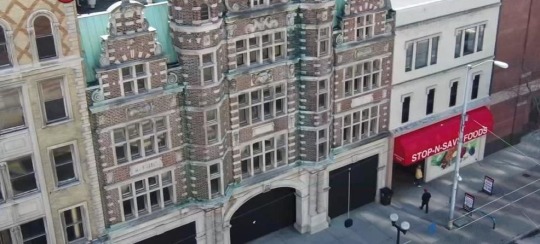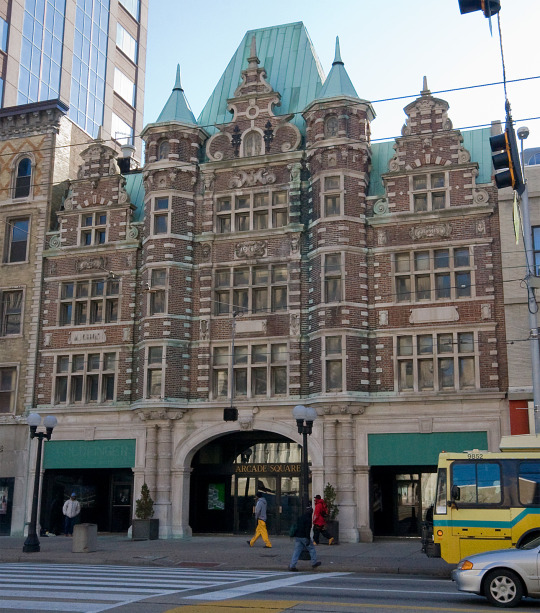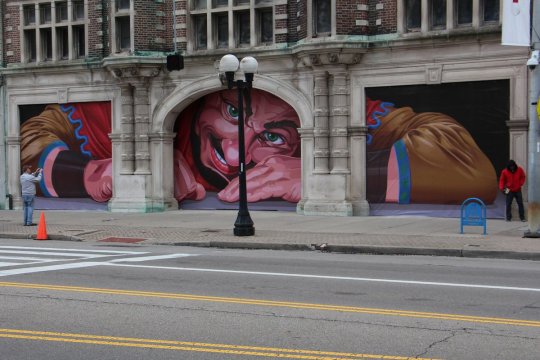#a wild turkey filled with dimes
Text

we are having wonderful storms this morning. the air is cool enough to have the back door all the way open and listen to the rain and the thunder. i had already planned a rest day after yesterday's jarring fall in the muddy woods, and this weather is unambiguous affirmation from the kami of rambles
i am still working on finding my next project, still in the middle of the dark uncertainty of it all. what comes next? every time it feels like nothing comes next. maybe this time nothing will. the story of me not going through the door

#mcteague#splatter#i like the sound of glass when it smashes#i like the color of smash when it ashes#i want to empty it out and start over but then they give me that look and i cant do it#i want to fill it with candy#i want to hear a new world#i want to be a turtle when i grow up#i saw a man so beautiful i started crying#once i saw a black fawn#i woke up in a different bed in a different town#broken appetites#bowls of cherries#a wild turkey filled with dimes#and that would fix everything
29 notes
·
View notes
Photo



The Dayton Arcade 15 W. Fourth Street Dayton, Ohio 45402 The Dayton Arcade is a collection of five buildings in Dayton, Ohio. The historic Arcade is an architecturally elegant complex in the heart of Dayton's central business district. Built between 1902 and 1904, it was conceived by Eugene J. Barney of the Barney and Smith Car Company and consists of five interconnecting buildings topped by a glass-domed rotunda, 70 feet high and 90 feet in diameter (detailing around the dome includes oak leaves and acorns, grain, rams' heads, wild turkeys, and cornucopia), below which two balconied upper floors circle the central enclave. As president of the Arcade Company, Barney made sure the Arcade had the latest innovations, including elevators, a power plant and a cold-storage plant. The architect was Frank M. Andrews, known also as architect for many of NCR's factory buildings (notable for their use of progressive fenestration) and the American Building (originally Conover) at Third and Main Streets in Dayton. The most notable building, which fronts on Third Street, is of Flemish design and is said to be patterned after a guild hall in Amsterdam, the Netherlands. It looks like typical old Dutch architecture. The Fourth Street and Ludlow Street facades are done in Italian Renaissance Revival with the Commercial Building anchoring the corner of the lot. The most interesting architectural feature is the great dome. The classic detailing usually found in such rotundas was replaced by detailing representing Ohio. The cornucopias are filled with fruit and vegetables from Ohio. There are festoons of oak leaves with acorns, ram heads, and garlands of grain. At each framing member of the dome are colorful turkeys. The construction of the group of buildings, known as the Arcade, was commenced on March 1, 1902, and completed on March 1, 1904. The Third Street Building has a frontage on Third Street of 66 feet, and was built by Mr. M. J. Gibbons and The Dayton Arcade Company. The Office Building has a frontage on Ludlow Street of 66 feet, and the Apartment Building has a frontage on Fourth Street of 200 feet. The buildings are of steel and concrete, fireproof construction throughout, and possessing every modern equipment and convenience. The elevator service is furnished by six Otis electric elevators, and the Power Building is equipped with a complete steam heating, electric light and refrigerating plant of the most modern type. Through each building runs spacious arcades, richly constructed of marble and mosaic tile, converging into the Arcade Market House, which, with its magnificent glass dome and beautifully decorated galleries surrounding and overlooking the Market House, is unlike any buildings in this country; artistic in conception and perfect in execution. Originally, the main spaces were used for a major food market, with retail stores, offices, and apartments on the upper floors. Through the first four decades of twentieth century, this super supermarket and retail center was one of downtown Dayton's prime attractions and destinations, offering the unusual in fruit and vegetables, seafood, baked goods, food specialties, meats and meat specialties, fresh-cut flowers, and assorted luxury items available in or out of season. In 1974, the Arcade was placed on the National Register of Historical Places. In the late 1970s, investors began planning and implementing a major restoration of the Arcade. In May 1980, the newly refurbished Arcade was reopened as a retail shopping and food center. In its new guise as Arcade Square, the center offered a lively collection of boutique stores, restaurants, stores offering staples, kitchen apparel, books, and luggage, and a museum devoted to Coca-Cola. The Dayton Philharmonic, among other offerings, performed to holiday crowds from the vast floor below the Arcade rotunda. Given the general decline of retail activity and volume within the central business district, financial success gradually eluded Arcade Square, and it was closed to the public in 1990. Its final tenants still included its famous Arcade Seafood store and the last traditional dime store to operate in Downtown Dayton, McCrory's, both of which remained open for a time after the closure of the Arcade Square public spaces themselves. Although currently mothballed, save for certain brief re-openings for holiday traffic, several plans are in the works by preservation organizations to reopen the Arcade and its adjacent upper levels. The building was in use until 1991 and remains empty today. Currently the Dayton Arcade is a dead mall. An Ohio not-for-profit group, "Friends of the Dayton Arcade" was created to advocate for the Arcade Building. The building was purchased by Dayton Arcade, LLC, for the minimum bid of $615,106.02. The new Arcade owners, Gunther Berg and Wendell Strutz said they would begin work on the Arcade restore the building to its former glory with mixed use developments - housing, offices, restaurants, and commercial space. Early estimates on the restoration total $30 million.
2 notes
·
View notes
Text
13 Underrated Places That Americans Are Allowed to Visit Now

As domestic travel ramps up in areas with dropping coronavirus cases, we will not help but turn our eyes to farther-flung destinations. While it's true that COVID-19 remains out there—and we should always all do our part to stop its spread—it's becoming possible for Americans to go away our shores and travel internationally another time, all the while following safety precautions, of course.
Though most countries haven't opened their borders to Americans, there is a growing number letting travelers in, provided all tourists meet a variety of health qualifications. Read on and find the underrated places hospitable American travelers now—none of which require 14-day quarantines upon arrival. And for more gorgeous getaways within your reach, inspect the 17 Stunning Islands That Americans Are Allowed to go to Now.
Editor's Note: We understand that travel is complicated immediately and restrictions vary. If you propose on visiting any of the below destinations, we recommend checking their official websites for possible closures, limited access announcements, and general health and safety guidelines.
1Albania
Albania has it all: beaches, mountains, ancient sites, and a fantastic Mediterranean climate. But the tiny country doesn't have the crowds of a number of its neighbors—doubly so during the pandemic. Americans seeking to go to Albania don't get to worry about coming in with a negative COVID test, but wearing a mask is mandatory publicly spaces throughout the country. aside from that, Albania is just about entirely open for business. And if you are feeling easier staying stateside, inspect the 17 American Towns So Beautiful You'll Think You're in Europe.
2Belarus
When most Americans consider visiting Europe, Belarus is perhaps not the destination that involves the mind. But the Eastern European country draws visitors for its impressive landscapes and wildlife (the rare European bison lives here), crumbling castles within the countryside, and vibrant capital city, Minsk. Americans aren't required to present a negative COVID test upon arrival, though their temperature could also be taken at the airport.
3Croatia
Arguably the foremost famous of the Balkan countries, Croatia's favorite tourist attraction is that the walled city of Dubrovnik, but the remainder of the country remains somewhat off-the-beaten-path for American tourists. If you are looking to explore Croatia with none massive crowds, now's the time to go—Americans are allowed to go to, provided they arrive with a negative COVID-19 PCR test administered within 48 hours of arrival. If you arrive with a negative test taken outside that window, you will have to quarantine for seven days, after which you'll take a test locally.
4Dominica
Prior to the pandemic, fewer than 100,000 tourists would spend the night on Dominica annually, with most visitors just stopping for the day while on a cruise. But the luxurious Caribbean Island is hospitable American tourists immediately, as long as they arrive with a negative COVID-19 PCR test that's but 72 hours old. Visitors must answer a health questionnaire 24 hours before arrival, and once on the island, they'll be subjected to further COVID testing. And if you would like to ascertain a number of America's most pristine atolls, inspect the 13 Secret Islands within the U.S. You Never Knew Existed.
5Egypt
If you've dreamt of seeing the good Pyramids of Giza, you'll make that dream a reality. Egypt has opened its borders to Americans who arrive with a negative COVID-19 PCR test taken within the last 72 hours. Americans may additionally get to show proof of insurance upon arrival. On the bottom, many businesses are open with capacity restrictions: restaurants, as an example, can only operate at 50 percent capacity.
6Montenegro
The picturesque Balkan country of Montenegro has just added us to its list of approved countries from which tourists can visit. U.S. travelers will get to present either "a negative PCR test result for a replacement coronavirus (SARS-CoV-2) or a positive result of an antibody to a replacement coronavirus (SARS-CoV-2) class IgG obtained by ELISA serological test," per the Institute of Public Health of Montenegro. There are not any published specifications on when the tests got to are administered, but we recommend checking with the U.S. Embassy within the country before booking any flights.
7North Macedonia
And yet one more Balkan country makes this list. North Macedonia—famous for its sculpture-filled capital, Skopje—is welcoming Americans with hardly any restrictions. Travelers from us must simply have their temperature taken once they reach the airport. If they need a fever, they're going to receive further evaluation from medical professionals. Masks and social distancing are required throughout the country, and a few capacity restrictions are in situ. Looking to urge faraway from it all? inspect the 17 Most Exotic Off-the-Grid Hotels within the World.
8Rwanda
Rwanda, one among the few countries where you'll see mountain gorillas within the wild, has opened its borders to Americans, but it's a rigorous testing protocol in situ. Americans must arrive with a negative COVID-19 PCR test taken within the last five days, but they'll even have to undergo additional PCR testing upon arrival within the country, followed by a 24-hour quarantine during a specially designated transit hotel—all on the traveler's dime.
9Saint Vincent and therefore the Grenadines
One of the least-visited Caribbean nations, Saint Vincent, and therefore the Grenadines may be a group of 32 islands, of which only nine are inhabited. Americans are welcome to go to all of them, as long as they arrive with a negative COVID-19 PCR test taken within five days of arrival or are willing to require a test locally and quarantine while awaiting the results. there is a notable exception, however: guests traveling to resorts or hotels on their own private island can arrive with a negative antibody test taken within five days of arrival.
10Serbia
Serbia is understood for its thriving capital Belgrade, quaint historic towns, spectacular landscapes, and wine. The country has no restrictions on Americans coming from us, but Americans who are traveling to Serbia via North Macedonia, Croatia, Bulgaria, or Romania must present a negative COVID-19 PCR test taken within the last 48 hours upon arrival. Once within the country, face masks are required altogether indoor spaces, also as outdoor areas where social distancing isn't possible.
11Tanzania
Between Mt. Kilimanjaro, the Serengeti, and Zanzibar, Tanzania has a number of the most important tourist draws in East Africa. Luckily for Americans, the country is hospitable to visitors immediately. Per the U.S. Embassy in Tanzania, "All travelers whether foreigners or returning residents whose countries or airlines require them to supply negative testing for COVID-19 as a condition for traveling are going to be required to present a certificate on arrival." it is a little unclear what that statement means for Americans, specifically, so it is best to contact the Embassy directly before booking a visit.
12Turkey
Whether you are looking to explore the town streets of Istanbul or the landscapes of Cappadocia, Turkey is waiting with open arms. Foreign tourists, including Americans, don't get to show any test results, but upon arrival in Turkey, they'll be checked for COVID-19 symptoms. If they show any signs of illness, they'll undergo a radical medical evaluation. While there's a curfew in situ for residents, visitors aren't subject thereto.
13Ukraine
With seven UNESCO World Heritage sites across the country, Ukraine may be a must-visit for history buffs, architecture lovers, and culture vultures—not to say foodies, who will enjoyment of Kyiv's underrated scene. The country is essentially hospitable tourists lately, including Americans, who must either arrive with a negative COVID-19 PCR test taken within the last 48 hours, take a PCR test upon arrival, and quarantine for twenty-four hours until results are in, or spend 14 days in quarantine sans testing. And for more safe spots to flee, inspect the 50 Beautiful, Obscure Places within the U.S. you ought to Visit This Summer.
0 notes